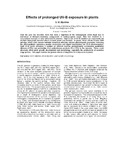Please use this identifier to cite or link to this item:
http://hdl.handle.net/10311/491| Title: | Effects of prolonged UV-B exposure in plants |
| Authors: | Mpoloka, S.W. |
| Keywords: | UV-B radiation ozone depletion plant growth morphology |
| Issue Date: | 2008 |
| Publisher: | Academic Journals. http://www.academicjournals.org/AJB |
| Citation: | Mpoloka, S.W. (2008) Effects of prolonged UV-B exposure in plants, African Journal of Biotechnology, Vol. 7 (25), pp. 4874-4883 |
| Abstract: | Over the past few decades, there has been a depletion of the stratospheric ozone layer due to emissions of halogen-containing compounds of anthropogenic origin. This has resulted in a concomitant increase in solar ultraviolet-B radiation. High levels of UV-B radiation are responsible for multiple biologically harmful effects in both plants and animals. In plants, these effects include DNA damage, which often causes heritable mutations affecting various physiological processes, including the photosynthetic apparatus, protein destruction and signal transduction via UV-B photoreceptors. High UV-B levels introduce a number of different lesions, predominantly cyclobutane pyrimidine dimmers (CPDs) and pyrimidine (6-4) pyrimidinone products [(6-4) PPs] in the genome. These could adversely affect plant growth, development and morphology, especially the productivity of sensitive crop species. This paper reviews the genetic effects of long-term UV-B exposure in plants. |
| URI: | http://hdl.handle.net/10311/491 |
| ISSN: | 1684–5315 |
| Appears in Collections: | Research articles (Dept of Biological Sciences) |
Files in This Item:
| File | Description | Size | Format | |
|---|---|---|---|---|
| Effects of prolonged.pdf | 2.29 MB | Adobe PDF |  View/Open |
Items in DSpace are protected by copyright, with all rights reserved, unless otherwise indicated.
